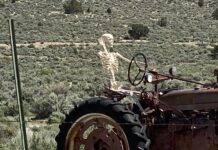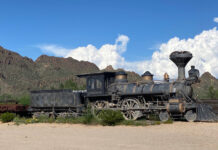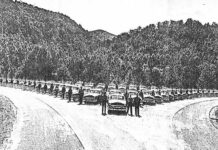by Kalen Goodluck/High Country News
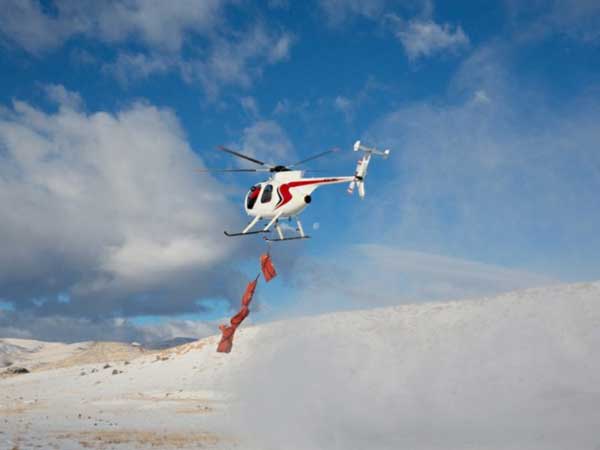
The day began early for the crew of scientists, state and tribal officials — long before the sun rose across the snow-covered sagebrush. “How many are you going to give us?” asked Alan Mandell, vice chairman of the Pyramid Lake Paiute Tribe. “Twenty to 25,” said a biologist, rubbing his palms together in the cold. “That’s a great start,” Mandell said, smiling.
All fell silent as a helicopter approached from the horizon above Nevada’s snowy Sheep Creek Range. “We have four,” crackled a voice over the radio. In the distance, the payload dangled in slings from the chopper’s haul: California bighorn sheep, carefully blindfolded. Emily Hagler, biologist and wetlands environmental specialist for the Pyramid Lake Paiute Tribe, stood back and watched the first one touch down in a swirl of snow. Teams rushed to the site, weighed the bighorns and placed them on tables for medical examinations.
It’s finally happening, Hagler thought, eyeing the bighorns. After decades of on-and-off negotiations between state and tribal agencies and time spent seeking grant funding as well as gathering tribal council and community support, the bighorns were coming home.
“This is just the next step in restoring another native species that has been lost.”
“We lost almost our entire fisheries that we’ve been working decades to recover,” said Hagler. “This is just the next step in restoring another native species that has been lost.”
For the first time in roughly a hundred years, the Pyramid Lake Paiute Tribe will have a flock of bighorn sheep on tribal land that was once a part of the sheep’s historic habitat. Not only will the effort help restore the species; it will also renew hunting and tanning traditions and support ceremonial uses — practices disrupted as the sheep population declined. The bighorns will be closely monitored for nearly three years to create a tailored conservation plan. “We won’t know what the herd will need to thrive until they’re on the landscape,” said Hagler. Restoring an animal to its native habitat is a time-consuming and expensive task. It’s also uncertain at times; sheep don’t always survive the stress of capture, and they are lethally susceptible to local livestock diseases. And after release, they’re on their own.
Once the sheep are captured, veterinarians collect blood samples, make age estimations, take nasal and throat swabs, and measure horns and necks for radio-collar fitting. Stressed-out bighorns that begin to overheat are wrapped in cold wet towels, packed in snow and given oxygen.
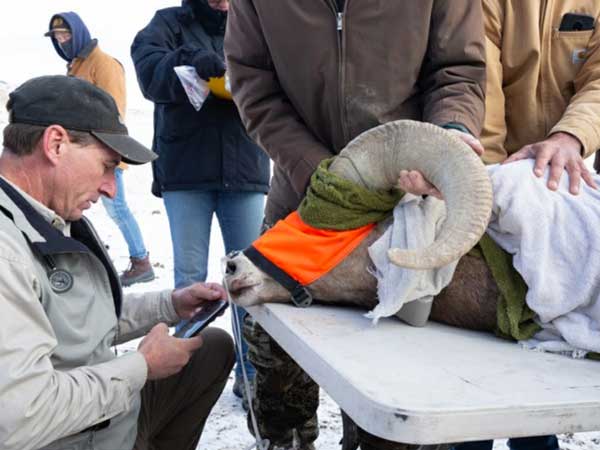
Over the last few decades, the Pyramid Lake Paiute’s natural resources department has been focused on recovering its fisheries in Pyramid Lake, home to two imperiled fish species. These efforts have taken a lot of resources and prevented tribal partnerships with the state during earlier bighorn reintroduction efforts. The endangered cui-ui, from which the tribe gets its name (Cui ui Ticutta, meaning “Cui-ui Eaters”), began to decline in the 1930s due to unrestricted water diversion and drought. Today, however, the population is increasing, thanks to tribal management and water regulation. The cui-ui, which the U.S. Fish and Wildlife Service describes as a “large robust sucker,” weighs nearly 8 pounds and can live for over 40 years. A rare fish with a royal blue tailfin, it can only be found in Pyramid Lake. The tribe also manages the threatened Lahontan cutthroat trout, which can only be found in a few lakes and streams in mid-eastern California and central Nevada. The Lahontan cutthroat lives between 5 and 15 years, but what it lacks in lifespan it makes up in mass, weighing up to 40 pounds. Now, thanks to a partnership with the Nevada Department of Wildlife, the bighorn sheep has joined the tribe’s conservation roster after decades of colonization, commercial hunting, urbanization and livestock overwhelmed the state’s bighorns.
“In terms of sovereignty, we could be pushing more of a Native management style that’s based in traditional management practices,” said Marissa Weaselboy, a citizen of the Yomba Shoshone Tribe and environmental specialist for Pyramid Lake. “Maybe some of it could be like tending areas that they could frequent, so they could carry seeds for replanting. I’m hoping how they work with the environment is they help with revegetation.”
Both written and archaeological records, based on bones and petroglyphs, reveal that bighorn sheep once thrived across Nevada. Revered as a “trailblazer” and “one of Nevada’s greatest heroes,” at least by some state officials and archaeologists, John Charles Frémont (1813-1890) carried out orders from the War Department to survey land across the West to further U.S. expansion efforts, including the “unknown land” that would later become Nevada. On one of these trips, he chronicled the bighorns that he saw, in writings that would later help the U.S. Fish and Wildlife Service identify the animal’s historic habitat. “We saw herds of mountain sheep, and encamped on a little stream at the mouth of the defile, about a mile from the margin of the water, to which we hurried down immediately,” Frémont wrote. The Frémont name is found everywhere in the West, from a casino-lit street in Las Vegas to the names of many plant species, and from the Fremont-Winema National Forest in California to the town where my mother grew up in the Bay Area.
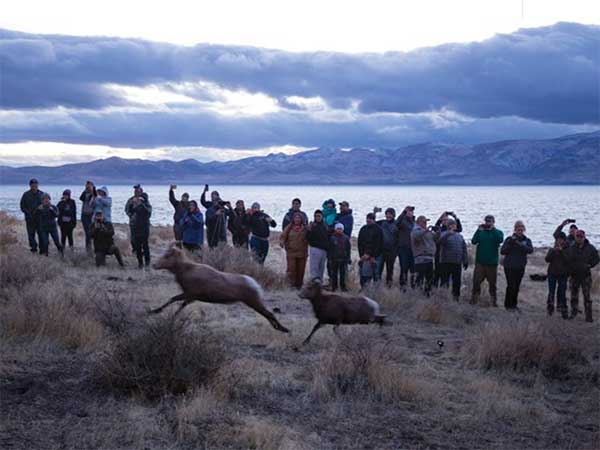
At noon, another gust of snow from the chopper signaled the arrival of the last five bighorns. The sheep-count capped at 22, with the rest packed in two Department of Wildlife stock trailers just beyond the veterinarian medic stations. With all the bighorns accounted for, the caravan set off for Lake Range, toward the eastern shore of Pyramid Lake, land normally off-limits to non-tribal members.
The sun set on the west side of Pyramid Lake. Its waters were aquamarine. Clouds circled the mountains. Two stock trailers rumbled down the dusty road. Participants were told by the state scientists to form a “V” around the trailer’s gate to direct the bighorns into the mountains.
In a matter of seconds, the ewe flock was gone, darting up a rocky slope to settle somewhere in the dark. Then, whoosh, a second flock of rams charged out of the gate. In 10 years, Emily Hagler hopes the population will be sustainable, with bighorns born from the flock and even more reintroduced from across the state.
“I just see herds of bighorn sheep all over the reservation in 20 years,” she said.
This story was originally published at High Country News on February 13, 2020



